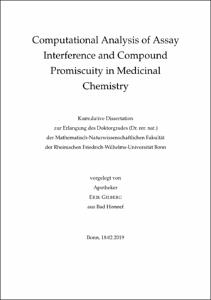Computational Analysis of Assay Interference and Compound Promiscuity in Medicinal Chemistry

Computational Analysis of Assay Interference and Compound Promiscuity in Medicinal Chemistry

| dc.contributor.advisor | Bajorath, Jürgen | |
| dc.contributor.author | Gilberg, Erik | |
| dc.date.accessioned | 2020-04-26T14:17:44Z | |
| dc.date.available | 2020-04-26T14:17:44Z | |
| dc.date.issued | 21.06.2019 | |
| dc.identifier.uri | https://hdl.handle.net/20.500.11811/7944 | |
| dc.description.abstract | Compound promiscuity offers both opportunities and perils for medicinal chemistry and drug discovery. On the one hand, it is well-established that compounds elicit their therapeutic potential by engaging with multiple proteins, giving rise to polypharmacology. On the other hand, promiscuous small molecules must be treated with caution, as their activity towards many targets is often associated with non-specific binding and assay interference. Thus, an essential step in drug discovery is to confirm true, beneficial, promiscuity by distinguishing it from artificial multitarget activity. This thesis aims to elicit molecular mechanisms of true multitarget activity, to separate them from those of assay interference, and to identify properties of molecules that can be exploited for polypharmacology. Hit compounds that originate from biological screening assays display a major resource for the exploration of promiscuity. Taking potential chemical liabilities of these compounds into account, 480 substructure patterns of pan-assay interference compounds (PAINS) have been put forward and are frequently used as structural alerts in screening efforts. In this thesis, the utility of extensively assayed promiscuous compounds as a starting point for the study of pharmacology is explored. In addition, limitations of PAINS filters are elaborated on the basis of crystallographic target-PAINS complexes and extensively assayed compounds. Further, series of analogs containing PAINS are generated to draw structure-activity relationships between PAINS displaying different activity profiles. To elucidate the structural context dependence of PAINS activities, structural features that favor correct predictions of PAINS activities by machine learning models are investigated with respect to their chemical interpretability. Moreover, analog series of extensively tested compounds displaying high hit rates are provided, allowing a systematic analysis of assay interference by circumventing shortcomings of PAINS filters. Uncertainties associated with screening data are avoided by validating the promiscuity of small molecules through their presence in experimentally determined target-ligand complexes. First, ligands are identified that are present in multiple complexes with distantly related or unrelated targets. These multifamily ligands are utilized for the generation of template structures that allow the design of polypharmacology candidates. Finally, chemical properties and binding modes of multifamily ligands are explored, revealing insight into the mechanisms that allow molecular recognition of ligands across distinct biological targets. | |
| dc.language.iso | eng | |
| dc.rights | In Copyright | |
| dc.rights.uri | http://rightsstatements.org/vocab/InC/1.0/ | |
| dc.subject | Wirkstoffforschung | |
| dc.subject | Polypharmakologie | |
| dc.subject | Promiskuität | |
| dc.subject | biologische screening assays | |
| dc.subject | Struktur-Wirkungsbeziehung | |
| dc.subject | Chemieinformatik | |
| dc.subject | molekulare Ähnlichkeit | |
| dc.subject | Drug Discovery | |
| dc.subject | screening | |
| dc.subject | Polypharmacology | |
| dc.subject | Promiscuity | |
| dc.subject | Biological assays | |
| dc.subject | Structure-Activity Relationship | |
| dc.subject | chemoinformatics | |
| dc.subject | molecular similarity | |
| dc.subject.ddc | 570 Biowissenschaften, Biologie | |
| dc.subject.ddc | 610 Medizin, Gesundheit | |
| dc.title | Computational Analysis of Assay Interference and Compound Promiscuity in Medicinal Chemistry | |
| dc.type | Dissertation oder Habilitation | |
| dc.publisher.name | Universitäts- und Landesbibliothek Bonn | |
| dc.publisher.location | Bonn | |
| dc.rights.accessRights | openAccess | |
| dc.identifier.urn | https://nbn-resolving.org/urn:nbn:de:hbz:5n-54919 | |
| ulbbn.pubtype | Erstveröffentlichung | |
| ulbbnediss.affiliation.name | Rheinische Friedrich-Wilhelms-Universität Bonn | |
| ulbbnediss.affiliation.location | Bonn | |
| ulbbnediss.thesis.level | Dissertation | |
| ulbbnediss.dissID | 5491 | |
| ulbbnediss.date.accepted | 07.05.2019 | |
| ulbbnediss.institute | Mathematisch-Naturwissenschaftliche Fakultät : Fachgruppe Molekulare Biomedizin / Life & Medical Sciences-Institut (LIMES) | |
| ulbbnediss.fakultaet | Mathematisch-Naturwissenschaftliche Fakultät | |
| dc.contributor.coReferee | Gütschow, Michael |
Dateien zu dieser Ressource
Das Dokument erscheint in:
-
E-Dissertationen (4077)




